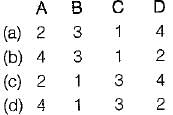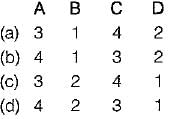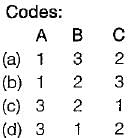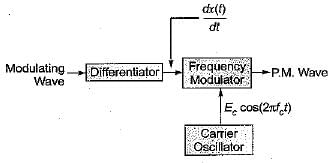Test: Angle Modulation - Electronics and Communication Engineering (ECE) MCQ
10 Questions MCQ Test GATE ECE (Electronics) Mock Test Series 2026 - Test: Angle Modulation
Match List-I with List-ll and select the correct answer using the codes given below the lists:
List-I
A. Pre-emphasis
B. Varactor
C. Voltage-controlled Oscillator
D. De-emphasis
List-ll
1. Voltage-variable capacitor
2. Uses a low-pass filter in a receiver
3. Frequency can be controlled by changing an external control voltage
4. Uses a high-pass filter in an FM transmitter.
Codes:

List-I
A. Pre-emphasis
B. Varactor
C. Voltage-controlled Oscillator
D. De-emphasis
List-ll
1. Voltage-variable capacitor
2. Uses a low-pass filter in a receiver
3. Frequency can be controlled by changing an external control voltage
4. Uses a high-pass filter in an FM transmitter.
Codes:

Assertion (A): There is less adjacent-channel interference in FM than in AM.
Reason (R): Standard frequency allocation provide a guard band between commercial FM stations.
Reason (R): Standard frequency allocation provide a guard band between commercial FM stations.
Match List-l (Type of transmission) with List-l I (Applications) and select the correct answer using the codes given below the lists:
List-l
A. Wideband FM
B. AM
C. Narrowband FM
D. Vestigial sideband transmission
List-lI
1. Radio broadcasting
2. Used for transmission of television signals
3. Used for high quality music transmission
4. Used for speech transmission (Police wireless, ambulance etc.)
Codes:

According to Carson’s rule, the bandwidth of FM wave is given by (Aω is the frequency deviation and ωm the modulating frequency)
Consider the following statements associated with angle modulations:
1. In FM, the frequency deviation is proportional to modulating frequency.
2. In PM, the frequency deviation is independent of modulating signal.
3. Amplitude of both FM and PM are constant.
4. It is possible to receive FM on a PM receiver and vice-versa.
5. Signal to noise ratio of PM is better than that of FM.
Which of the statements given above are correct?
We can obtain PM from frequency modulator by passing the modulating signal through a
Match List-l (Type of modulation) with List-II (Noise immunity) and select the correct answer using the codes given below the lists:


A FM wave is represented by the following equation:
v = 10 sin [5 x 10B t + 4 sin 1250 t]
Its maximum deviation is around.
In a FM system, the modulating frequency fm = 1 kHz, the modulating voltage Vm= 2 volt and the deviation is 6 kHz. If the modulating voltage is raised to 4 volt then what is the new deviation?
|
25 docs|263 tests
|




























